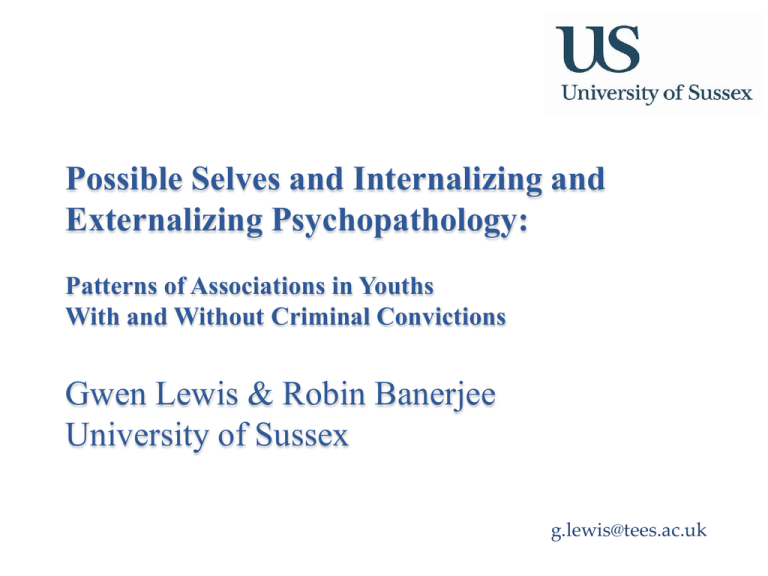Possible Selves and Internalizing and Externalizing
advertisement

Possible Selves and Internalizing and Externalizing Psychopathology: Patterns of Associations in Youths With and Without Criminal Convictions Gwen Lewis & Robin Banerjee University of Sussex g.lewis@tees.ac.uk Background • a third of young offenders in community and custodial contexts have mental health needs (Harrington & Bailey, 2005) • links with negative health outcomes (Piquero, Shephard, Shepheard & Farrington, 2011; Wiesner, Kim & Capaldi, 2005) • links with negative social outcomes (McClusky, Mc Cluskey & Bynum, 2006; Piquero, Farrington, Nagin & Moffit, 2010). • role of self-concept separately studied in psychopathology and youth offending (Abrams & Hyhn, 2009; Garaigordobil, Dura & Perez, 2005) • but little attention to the interplay of self-concept constructs, youth offending and mental health. Possible Selves and Youth Offending • Possible selves (Markus & Nurius, 1986): o expected selves o future hoped for and feared selves o particularly salient during adolescence • Delinquent youths have: Less achievement orientated possible selves (Lewis, 2010; Oyserman & Markus, 1990) More negative possible selves (Oyserman & Markus, 1990) Less balance between hoped and feared selves (Oyserman & Saltz, 1993) Underdeveloped strategies to attain possible selves (Abrams & Aguilar, 2005). Possible Selves and Psychopathology Externalizing problems and possible selves: • esteem enhancement models of delinquency (Cohen, 1955): o self-devaluating experiences negative self attitudes reassert a positive sense of self via non-normative, defensive, and aggressive strategies • cognitive theories of antisocial personality disorder (Beck, Freeman & Associates, 1990) and biases in social information processing (e.g., Crick & Dodge, 1994) Internalizing problems and possible selves: • Cognitive perspectives on anxiety and depression (Beck, 1967; Clark & Wells, 1998) o internalizing disorders involve negative views of self, world and future as well as increased fears Aims • Associations between possible selves and psychopathology in young men with convictions for – or at risk of – criminal offences • Strategies for achieving hoped-for and avoiding feared selves expected to be linked with psychopathology • Appraisals of possible selves expected to be linked with psychopathology o Positive beliefs about hoped-for selves should predict lower psychopathology o Greater perceived likelihood of, and worry about, feared selves should predict higher psychopathology o Possibility of moderation by conviction status? Sample • 95 males aged 16-22 year old (Mean 18 years) • Ethnicity: 33% White, 53% Black, 10% Mixed, 2% Asian, 2 % Other • Recruited from: o Community schemes for youths at risk of crime (N=67) o NACRO training centres for at risk of/involved in the criminal justice system (N=14) o Young Offenders Institute (N =14) • Criminal convictions – 34% had convictions and 66% did not Research Methodology Self report questionnaires: up to three expected, hoped and feared possible selves appraisals of hoped-for and feared selves in terms of: perceived importance, capability to achieve/avoid possible selves likelihood of possible selves becoming reality time spent thinking about possible selves strategies to achieve avoid possible selves. Externalizing and internalizing psychopathology - Adult Self Report (ASR) (Achenbach & Rescorla, 2003). Results Convictions and Psychopathology • Youths with convictions: higher on rule-breaking psychopathology Content of Possible Selves • trend toward less achievement orientated possible selves among those with convictions Hoped Selves Feared Selves Expected Selves ‘In jail’ ‘Become a professional music engineer’ ‘I’m afraid of becoming to paranoid’ Appraisals of Possible Selves Hoped For Selves • Composite score for: importance, capability, likelihood, and time spent thinking about hoped-for selves, a = .72 • Composite appraisal score negatively predicted Internalizing (b = -.25, p = .029) but not Externalizing (p > .10) • No evidence of moderation by conviction status (interaction terms, p > .10) Feared Selves • Time spent thinking about feared selves predicted Externalizing (b = .27, p = .045) and Internalizing (b = .30, p = .021) • Capability of avoiding feared selves predicted Externalizing (b = -.25, p = .031) and Internalizing (b = -.31, p = .009) • Importance of avoiding feared selves significantly higher on average for those with convictions AND • Conviction status moderated the relationship between importance ratings and psychopathology (interaction terms, ps < .05) o Importance of avoiding feared selves associated with lower externalizing and internalizing, but only in those with convictions (rs = -.38 and -.42, ps < .05) Strategies to Attain or Avoid Possible Selves Strategy to Attain Strategy to Avoid Hoped For Self Feared Self No Externalizing Yes t No Yes t .65 (.38) .47 (.39) 2.17* .55 (.37) .50 (.42) 0.65 Rule Breaking .62 (.36) .43 (.41) 2.15* .48 (.38) .49 (.43) -0.08 Aggressive .69 (.46) .50 (.39) 1.98* .62 (.39) .51 (.44) 1.30 .60 (.51) .37 (.35) 2.27* .51 (.47) .35 (.36) 1.91 Withdrawn .61 (.57) .33 (.38) 2.37* .52 (.51) .31 (.37) 2.21* Anxious/Depressed .58 (.48) 38 (.38) .51 (.45) .38 (.38) 1.44 Internalizing • 2.21* no interactions with conviction status Implications • utility of possible selves interventions to increase school involvement (Oyserman, Terry & Bybee, 2002) and address drug abuse (Buirs & Martin, 1997). • targeted possible selves interventions to equip young people experiencing psychopathology with strategies to: o achieve their hoped selves o avoid repeated delinquent experiences. • key focus on increasing self-efficacy and the development of attainable hoped selves, rather than simply arousing fear A Hopeful Note... • Young offenders often showed intricate conceptualisations of themselves in the future • possible benefits of providing a ‘hook’ (e.g., sport) to promote desistance from crime and offer avenues for alternative positive self definition (see Lewis & Meek, 2012) References Abrams, L. S. & Aguilar, J. P. (2005). Negative trends, possible selves and behaviour change. Qualitative Social Work, 42 (2), 175196. Abrams, L. S., & Hyhn, A. (2009). Mapping processes of negotiated identity among incarcerated male juvenile offenders, Youth & Society, 41 (1), 26-52. Achenbach, T. M. & Rescorla, L. A. (2003). Manual for the ASEBA adult forms & profiles. Burlington, VT: University of Vermont, Research Centre for Children, Youth & Families. Beck, A. T. (1967). Depression: Clinical, experimental, and theoretical aspects. New York: International Universities Press. Beck, A. T., Freeman, A. & Associates. (1990). Cognitive therapy for personality disorders. New York: Guilford Press. Buris, R, S. & Martin, J. (1997). The therapeutic construction of possible selves: imagination and its constraints. Journal of Constructivist Psychology, 10, 153-166. Clark, D. M. & Wells, A. (1995). A cognitive model of social phobia. In R. Heimberg, M. Liebowitz, D. A. Hope & F. R. Schneier (Eds.), Social phobia: Diagnosis, assessment and treatment (pp. 69–93). New York: Guilford Press. Cohen, A. K. (1955). Delinquent Boys. Glencoe: Free Press. Crick, N. R. & Dodge, K. A. (1994). A review and reformulation of social information- processing mechanisms in children’s social adjustment. Psychological Bulletin, 115 (1), 74-101. Garaigordobi, M., Dura, A. & Perez, J, I. (2005). Psychopathological symptoms, behavioural problems and self-concept/selfesteem: A study of adolescents aged 14 to 17 years old. Annuary of Clinical & Health Psychology, 1, 53-63. Harrington, R. & Bailey, S. (2005). Mental health needs and effectiveness of provision for young offenders in custody and in the community. Retrieved from: http://www.yjb.gov.uk/publications/Resources/Downloads/MentalHealthNeedsfull.pdf Lewis, G. & Meek, R. (2012). The role of sport in reducing reoffending among young men in prison: assessing the evidence base. Forensic Update, 107 July, 12-18. Lewis, G. (2010). Conceptions of possible selves and adolescent drug use. (Unpublished BSc Dissertation). University of Southampton: Southampton. Markus, H. & Nurius, P. (1986). Possible Selves. American Psychologist, 41 (9), 954–969 References cont... Oyserman, D. & Fryberg, S. (2006). The possible selves of diverse adolescents: Content and function across gender, race and national origin. In C. Dunkel & J. Kerpelman (Eds.), Possible selves, theory research and applications (pp. 17-39). New York: Nova Science Publishing Inc. Oyserman, D. & Markus, H. R. (1990). Possible selves and delinquency. Journal of Personality and Social Psychology, 59 (1), 112 – 125. Oyserman, D., Terry, K. & Bybee, D. (2002). A possible selves intervention to enhance school involvement. Journal of adolescence, 25, 313– 326. Piquero, A. R., Shephard, I., Shepheard, J, P. & Farrington, D. P. (2011). Impact of offending trajectories on health: Disability, hospitalisation and death in middle aged men in the Cambridge study in delinquent development. Criminal Behaviour and Mental Health, 21 (3), 189-201. Wiesner, M. Kim, H. K. & Capaldi, D. M. (2005). Developmental trajectories of offending: Validation and prediction to young adult alcohol use, drug use and depressive symptoms. Development & Psychopathology, 17 (1), 251-270.









